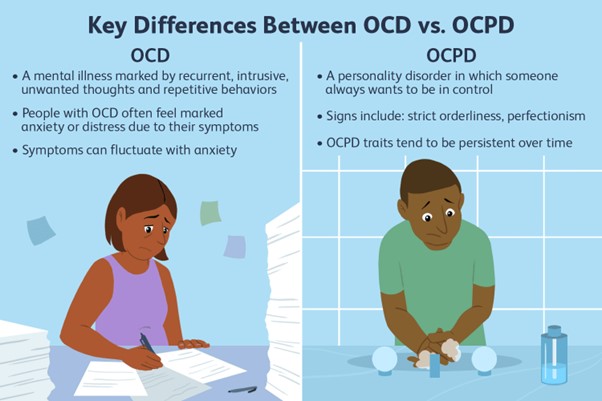A nurse is assessing a client who has obsessive-compulsive personality disorder. Which of the following findings should the nurse expect?
Goal-oriented
Provocative behaviour
Lack of empathy
Lability
The Correct Answer is A
Choice A reason:
Goal – oriented is the correct answer. Obsessive-compulsive personality disorder (OCPD) is a personality disorder characterized by a pattern of preoccupation with orderliness, perfectionism, and control. Individuals with OCPD tend to be highly organized, detail-oriented, and focused on achieving their goals. They often set strict standards for themselves and others and are driven by a strong need for perfection in all aspects of their lives.
Choice B reason
Provocative behaviour is not a characteristic commonly associated with obsessive-compulsive personality disorder (OCPD). In fact, individuals with OCPD tend to be more reserved, cautious, and serious in their interactions with others.
Choice C reason:
Lack of empathy While individuals with OCPD may struggle with interpersonal relationships due to their rigid standards and expectations, they typically do not lack empathy. They might find it challenging to understand and relate to emotions or perspectives that do not align with their own, but this is different from a complete lack of empathy, which is more commonly seen in certain other personality disorders
Choice D reason.
Lability refers to emotional instability or rapid and extreme shifts in emotions. This is not a typical feature of obsessive-compulsive personality disorder (OCPD). Individuals with OCPD tend to be emotionally restrained and might have difficulty expressing emotions, rather than experiencing emotional lability.

Nursing Test Bank
Naxlex Comprehensive Predictor Exams
Related Questions
Correct Answer is ["A","B","C","G","H"]
Explanation
The correct answer is choice A. Persistent headache, B. Nausea and vomiting, C. Right epigastric pain, G. Proteinuria 2+, H. Deep tendon reflexes (DTR) 3+ bilaterally. Choice A rationale: Persistent headache is a significant symptom that can indicate increased intracranial pressure or other serious conditions, especially in a pregnant client. It requires follow-up to rule out complications such as preeclampsia. Choice B rationale: Nausea and vomiting, particularly when severe and persistent, can lead to dehydration and electrolyte imbalances. In the context of pregnancy, it can also be a sign of a more serious underlying condition that needs to be addressed. Choice C rationale: Right epigastric pain is concerning as it can be indicative of liver involvement, which is a serious complication in pregnancy. This symptom needs immediate follow-up to assess for conditions such as HELLP syndrome. Choice D rationale: Slight facial edema can be a normal finding in pregnancy, but it can also be a sign of fluid retention associated with preeclampsia. However, on its own, it is not as critical as the other symptoms listed. Choice E rationale: A heart rate of 88/min is within the normal range for adults and does not typically require follow-up unless accompanied by other concerning symptoms. Choice F rationale: Blood pressure of 140/90 mmHg is elevated and concerning in pregnancy, but it is not included in the correct answers because the other symptoms are more directly indicative of severe complications. Choice G rationale: Proteinuria 2+ is a significant finding that suggests kidney involvement and is a key diagnostic criterion for preeclampsia. This requires immediate follow-up. Choice H rationale: Deep tendon reflexes (DTR) 3+ bilaterally are hyperactive and can indicate neurological irritability, which is a concerning sign in the context of preeclampsia. This finding needs follow-up to prevent complications such as seizures. Choice I rationale: Fundal height measurement of 26 cm at 30 weeks of gestation is below the expected range and may indicate intrauterine growth restriction (IUGR) or other issues, but it is not as immediately critical as the other findings listed.
Correct Answer is D
Explanation
The correct answer is choice d. Measure the client’s abdominal girth daily.
Choice A rationale:
Positioning the client supine with legs elevated is not recommended for managing ascites. This position does not help in reducing fluid accumulation in the abdomen and may worsen respiratory issues.
Choice B rationale:
Keeping the client’s daily protein intake below 0.8 g/kg is not typically recommended for clients with cirrhosis and ascites. Adequate protein intake is necessary to prevent muscle wasting and maintain nutritional status.
Choice C rationale:
Restricting the client’s sodium intake to 2 g not 3g per day is a common intervention for managing ascites, but it is usually more restrictive, often around 2 g per day, to effectively reduce fluid retention.
Choice D rationale:
Measuring the client’s abdominal girth daily is essential for monitoring the progression of ascites. It helps in assessing the effectiveness of treatment and detecting any worsening of the condition.
Whether you are a student looking to ace your exams or a practicing nurse seeking to enhance your expertise , our nursing education contents will empower you with the confidence and competence to make a difference in the lives of patients and become a respected leader in the healthcare field.
Visit Naxlex, invest in your future and unlock endless possibilities with our unparalleled nursing education contents today
Report Wrong Answer on the Current Question
Do you disagree with the answer? If yes, what is your expected answer? Explain.
Kindly be descriptive with the issue you are facing.
